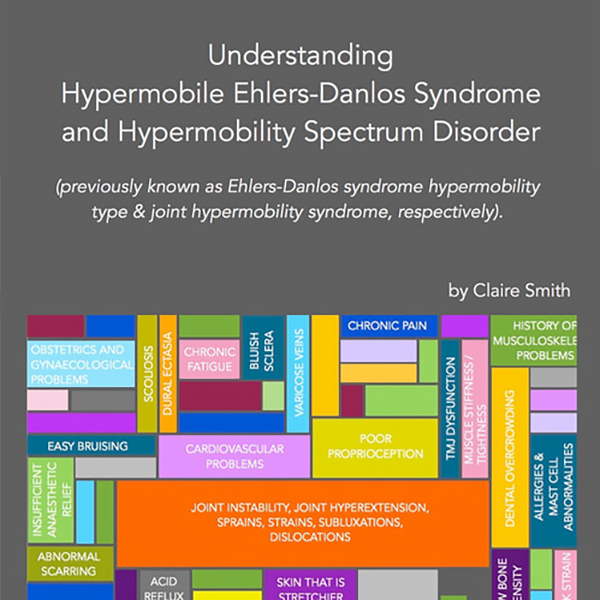
May is International EDS and HSD awareness month! These conditions are more common than previously thought and not well understood. Many patients wait decades for a diagnosis.
People with Hypermobile Ehlers Danlos Syndrome (hEDS) or Hypermobility Spectrum Disorder (HSD) have faulty connective tissue throughout their entire body. This not only leads to joint hypermobility but can lead to many other issues in other systems in the body. Connective tissue is found in every tissue and organ in the body. Fascia is made up completely of connective tissue. Bone, ligaments, tendons, cartilage, blood, and adipose tissue are all specialised connective tissues.
People with hEDS or HSD can suffer from gut issues, extreme fatigue, pelvic and bladder problems, poor proprioception, and anxiety among many other symptoms. Joining the dots to understand their condition as well as finding aware healthcare providers and movement teachers is a real challenge for these patients. They need your help and are looking for EDS and HSD aware Pilates teachers.
Pilates has been found in the top three of most helpful exercise modalities for adult individuals with Hypermobility Spectrum Disorder or Hypermobile Ehlers Danlos Syndrome, (Simmonds et al, 2017). People with these conditions are seeking out Pilates to improve their movement, joint stability, strength, and quality of life.
I have worked with patients amongst my caseload with hEDS and HSD for many years in my clinic and Pilates studio. More recently, I have participated as well as presented in the EDS Society UK’s ‘Allied Health Professionals Australian ECHO’ program, designed to educate healthcare professionals about hEDS and HSD. To play my part in raising awareness of hEDS or HSD this year I’m submitting the following book review.
Introducing the book, “Understanding Hypermobile Ehlers-Danlos Syndrome and Hypermobility Spectrum Disorder” by Claire Smith.
This is an excellent source of up-to-date information on these conditions.
Claire has written a comprehensive reference book on hEDS and HSD. She has done all the hard work, making learning about all the current information easy. The book is easy to navigate and written in easy-to-understand language. It is written for patients, carers, and health practitioners.
Within the book, Claire explains the conditions and the effects of a disorder of the connective tissue on the whole body. She also introduces the new term, Hypermobility Spectrum Disorder and the hypermobility spectrum, that many of our Pilates clients would find themselves on. Some of your clients may have one of these conditions without even being aware.
The book is divided into three chapters. Chapter one, titled “Frequently Asked Questions” sheds light on the new classification system for these disorders. In chapter two, the plethora of symptoms and co-morbidities are explained. The third chapter deals with the diagnosis and management of hEDS and HSD.
The Pilates teaching community can play a key role in supporting the movement journey of this population. As hEDS and HSD aware Pilates teachers, the healthcare support team for these individuals can be boosted so favourably. This reference book contains all the information needed to become an hEDS and HSD aware Pilates teacher.
I highly recommend this book and consider it a “must read” for any movement teacher. I also advocate that it be a textbook for any Pilates teacher training course.
To purchase visit : “Understanding Hypermobile Ehlers- Danlos Syndrome and Hypermobility Spectrum Disorder”, Claire Smith. Published by Redcliff House, 2017.
Lisa Anthony
PAA Professional Principal Trainer Member, Physiotherapist, ConnectTherapy™ Certified Practitioner, Pilates Instructor
About Lisa
Lisa has been the Director of PhysioXtra; Care Expertise Results, on the NSW Central Coast for 28 years. Lisa was the Principal Practitioner of Central Coast Pilates for 17 years, a Pilates studio within the Physiotherapy clinic.
Lisa has trained extensively in the Pilates method since 1998. She holds a Cert 4 of Pilates Instruction (PITC 2005), Diploma of Pilates Practice (PITC 2006), Advanced Diploma of the Pilates Method (PITC 2010) and is a Certified Polestar Pilates Rehab Practitioner (Polestar Australia 2010). Lisa is also a Professional Principal Trainer member of the PAA. In 2019 Lisa was proud to become a Dr Linda Joy Lee Certified ConnectTherapy™ Practitioner.
Lisa works has worked with patients with hEDS and HSD for many years in her clinic and Pilates studio. She is a participant and has also recently presented in the EDS Society UK’s ‘Allied Health Professionals ECHO’ program, designed to educate healthcare professionals about hEDS and HSD.

Comments are closed.